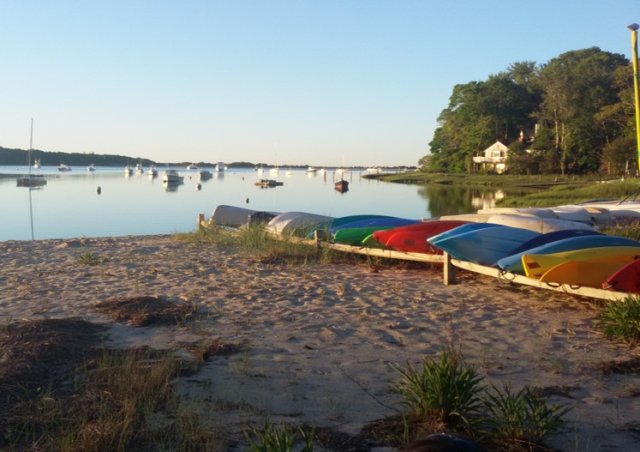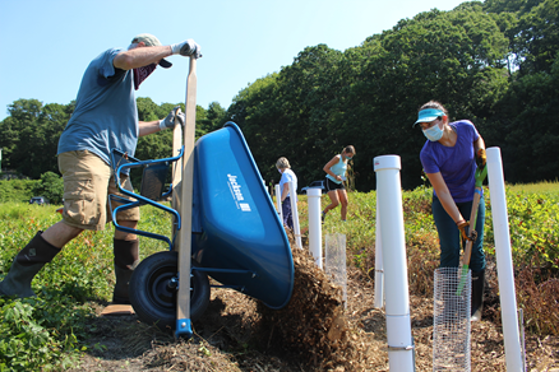EPA Scientists and Partners Team Up to Tackle Cape Cod’s Nutrient Pollution and Protect Water Quality

Published June 7, 2022
Cape Cod, Massachusetts, is known for its picturesque villages, sandy beaches, and seafood. But these iconic coastal waters, and the communities and ecosystems they support, are under an increasing threat from nutrient pollution.
Like many places in the country, Cape Cod’s coastal waters are under stress from excess nutrients, which mainly consist of nitrogen. While nitrogen and other nutrients occur naturally in the environment, too many nutrients can cause water to become polluted. Nutrient pollution from human activity can throw natural water systems out of balance, leading to algal blooms and contributing to low oxygen conditions that harm aquatic ecosystems and can cause fish kills.
To help Cape Cod solve its nutrient pollution problem, EPA researchers are collaborating with federal, state, and community partners. This diverse group of partners came together with the common goal of restoring the water quality and natural ecosystems on which the region depends. Their work includes research to better understand nutrient pollution in the region, field testing nitrogen-removal technologies, and developing communication methods to engage community members throughout the research process.

“This is a partner-centric project,” says EPA science lead Tim Gleason. “We began with problem formulation, talking to partners to understand their needs for more pilot studies of non-traditional approaches, and then co-designing the research with our partners. We have a mix of scientists working closely with partners to come up with solutions to an environmental problem.”
Tackling the excess nutrients impacting Cape Cod waters will take a multi-faceted approach that involves both environmental and social solutions. Since nutrient pollution comes from many small sources, it’s difficult to develop a single solution for management efforts, though most of the controllable nitrogen load comes from septic systems. The project team is exploring ways to reduce nutrient pollution at the source, including testing innovative low-nitrogen septic systems. Researchers are also investigating the nitrogen-removing potential of cranberry bogs and shellfish farms to combat excess nutrients in the environment. Concurrently, social scientists are studying local perceptions of these nitrogen-removing technologies to better understand their social benefits and trade-offs.
“The complexity of the problem leads to the complexity of solutions. The point of this project is to identify solutions and see what works,” says EPA social scientist Kate Mulvaney.
This multi-faceted research project is part of EPA’s solutions-driven research initiative, which emphasizes working directly with stakeholders to solve complex public health and environmental problems. The knowledge gained from this work can be applied to other communities across the country grappling with nutrient pollution.
The project includes several research components to characterize and address excess nitrogen in the Cape Cod watershed, which are:
- Innovative Septic Systems Research Pilot: EPA scientists are partnering with the Barnstable Clean Water Coalition (BCWC), the Massachusetts Alternative Septic System Test Center, the U.S. Geological Survey, The Nature Conservancy, the Town of Barnstable, and others to replace traditional septic systems with enhanced nitrogen-reducing septic systems in the Sand Shores neighborhood of Barnstable, MA. The team began installing the innovative septic systems in 2021 and will monitor their performance over the next three years. Social science research conducted by EPA with homeowners from regional innovative septic pilots has helped researchers and decisionmakers understand factors influencing homeowners’ willingness to adopt these new systems. Learn more about the pilot demonstration.
- Cranberry Bogs Research Pilot: EPA researchers are collaborating with the BCWC, Mount Holyoke College, the Massachusetts Department of Ecological Restoration, and others to explore the nitrogen-removing potential of retired cranberry bogs converted to wetlands. Scientists will measure the change in nitrogen processing for multiple restoration options. Social science research carried out by EPA will help the team understand local perspectives on the value of bog restoration. Learn more about the cranberry bogs research pilot.
- Aquaculture Research: EPA researchers collaborated with shellfish aquaculturists in Rhode Island to study the ability of oyster farms to remove nitrogen. Additional research efforts are determining if shellfish operations can improve water clarity to support seagrass, overall water quality and assessing the social benefits of and barriers to shellfish aquaculture. Learn more about the aquaculture research project.
- Benthic Conditions Survey Research: With support from the Massachusetts Department of Environmental Protection, EPA researchers assessed the benthic, or seafloor, conditions of the Three Bays estuary. Benthic conditions indicate the habitat’s response to stressors, giving scientists a glimpse into the current state of the estuary. Read the project publication: Summary of benthic conditions in the Three Bays estuary (Cape Cod, MA) as of 2019.
- Reuse of Dredged Material Research: EPA scientists are exploring ways to reuse sediments dredged from waterways. Reusing dredged materials to create wetlands could help remove nitrogen in the water system. Researchers are studying the impact of dredged material on nitrogen processing through greenhouse experiments. Learn more about the reuse of dredged material research.
- Recreational Benefits of Improved Water Quality Research: EPA social scientists are studying the value of improving water quality in Cape Cod. Since 2016, this work has helped determine how visitors use the coast for recreation, and how water quality and water pollution might affect recreation. This information will help decision-makers and residents better understand and estimate the value of water quality improvements on Cape Cod. Learn more about recreational benefits of improved water quality research.
- Harmful Algal Blooms Research: Based on interest from people in the area, EPA scientists expanded the original project to include field research on harmful algal blooms. The researchers are coordinating with the Town of Barnstable, MA, and the Barnstable Clean Water Coalition to assess the water quality of freshwater lakes and ponds. The team is collecting data from automated sampling buoys, traditional sampling methods, novel sampling approaches, and remote sensing to gain insight into how water conditions drive algal blooms.
Related Links:
EPA Scientists Develop Methods for Estimating Recreational Visitors and Value of Cape Cod Estuaries
